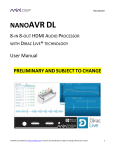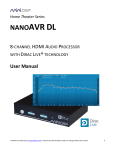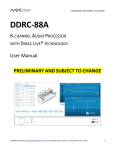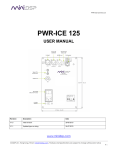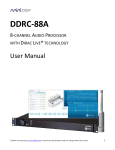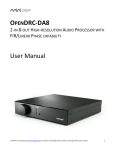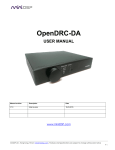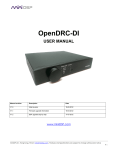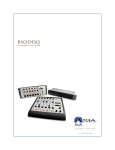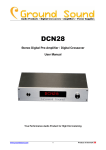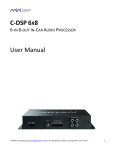Download miniDSP DDRC User Guide
Transcript
DIRAC SERIES HIGH-RESOLUTION AUDIO PROCESSORS WITH DIRAC LIVE® TECHNOLOGY User Manual DDRC-22A DDRC-22D miniDSP Ltd – Hong Kong / Email : [email protected] / Features and specifications subject to change without prior notice 1 Revision history Revision 0.9 1.0 Description Initial public release First production version Date 26 Mar 2014 4 April 2014 miniDSP Ltd – Hong Kong / Email : [email protected] / Features and specifications subject to change without prior notice 2 TABLE OF CONTENTS Important Information......................................................................................................................................... 5 System Requirements ...................................................................................................................................... 5 Disclaimer/Warning ......................................................................................................................................... 5 Warranty Terms ............................................................................................................................................... 5 Package Contents ............................................................................................................................................ 6 A Note on this Manual ..................................................................................................................................... 6 1 Product Overview .......................................................................................................................................... 7 1.1 Typical system configurations ............................................................................................................... 7 1.2 How Dirac Live® works ......................................................................................................................... 8 1.3 The Dirac Series / Dirac Live® design process ...................................................................................... 10 2 Installation and Setup .................................................................................................................................. 11 2.1 Hardware connectivity ....................................................................................................................... 11 2.1.1 Digital audio connections (DDRC-22D) ........................................................................................ 11 2.1.2 Analog audio connections (DDRC-22A)........................................................................................ 11 2.1.3 DC Power.................................................................................................................................... 12 2.1.4 USB............................................................................................................................................. 12 2.2 Software installation and license activation ........................................................................................ 13 2.2.1 Framework installation ............................................................................................................... 13 2.2.2 Software installation ................................................................................................................... 13 2.2.3 License activation ....................................................................................................................... 13 2.2.4 License validation ....................................................................................................................... 14 3 Acoustic Measurement................................................................................................................................ 15 3.1 Loudspeaker and microphone positioning .......................................................................................... 15 3.2 Connections for acoustic measurement .............................................................................................. 16 3.3 Configuring for measurement............................................................................................................. 17 3.3.1 Sound System tab ....................................................................................................................... 18 3.3.2 Mic Config tab ............................................................................................................................ 18 3.3.3 Output & Levels tab .................................................................................................................... 19 3.4 Running the measurements................................................................................................................ 20 3.4.1 Listening environment ................................................................................................................ 20 3.4.2 Executing measurements ............................................................................................................ 21 3.4.3 Viewing and redoing measurements ........................................................................................... 22 3.4.4 Completing the measurements ................................................................................................... 22 3.5 Saving and loading projects ................................................................................................................ 22 4 Filter Design ................................................................................................................................................ 23 4.1 Working with graphs .......................................................................................................................... 23 4.2 Designing your target curve ................................................................................................................ 25 4.2.1 The Auto Target .......................................................................................................................... 25 4.2.2 Editing the target curve .............................................................................................................. 26 4.2.3 Guidelines for target curve design .............................................................................................. 27 4.2.4 Saving and loading target curves ................................................................................................. 28 miniDSP Ltd – Hong Kong / Email : [email protected] / Features and specifications subject to change without prior notice 3 4.3 Generating correction filters............................................................................................................... 28 4.4 Downloading and managing filter sets ................................................................................................ 29 5 Using the Dirac Series audio processor ........................................................................................................ 31 5.1 Status indicators ................................................................................................................................. 31 5.2 Front panel controls ........................................................................................................................... 31 5.3 Infrared remote control ...................................................................................................................... 32 6 Additional Information ................................................................................................................................ 33 6.1 Specifications ..................................................................................................................................... 33 6.2 Troubleshooting ................................................................................................................................. 34 6.3 MCU Firmware upgrade ..................................................................................................................... 35 6.4 Obtaining Support .............................................................................................................................. 36 miniDSP Ltd – Hong Kong / Email : [email protected] / Features and specifications subject to change without prior notice 4 IMPORTANT INFORMATION Please read the following information before use. In case of any questions, please contact miniDSP at [email protected]. SYSTEM REQUIREMENTS To configure your Dirac Series audio processor, you will require a Windows PC with the following minimum specification: Intel Pentium III or later, AMD Athlon XP or later 2 Gigabytes (GB) of RAM or higher Keyboard and mouse or compatible pointing device Microsoft• ® Windows® Vista® SP1/Win7/Win8 Microsoft• ® .NET framework v3.5 or later Two free USB 2.0 ports DISCLAIMER/WARNING miniDSP cannot be held responsible for any damage that may result from the improper use or incorrect configuration of this product. Please read this manual carefully to ensure that you fully understand how to operate and use this product, as incorrect use or use beyond the parameters and ways recommended in this manual have the potential to cause damage to your audio system. Please also note that many of the questions we receive at the technical support department are already answered in this User Manual and in the online application notes on the miniDSP.com website. So please take the time to carefully read this user manual and the online technical documentation. And if an issue arises with your unit, please read through the Troubleshooting section first. Thank you for your understanding! WARRANTY TERMS miniDSP Ltd warrants this product to be free from defects in materials and workmanship for a period of one year from the invoice date. Our warranty does not cover failure of the product due to incorrect connection or installation, improper or undocumented use, unauthorized servicing, modification or alteration of the unit in any way, or any usage outside of that recommended in this manual. If in doubt, contact miniDSP prior to use. miniDSP Ltd – Hong Kong / Email : [email protected] / Features and specifications subject to change without prior notice 5 PACKAGE CONTENTS Your Dirac Series package includes: One Dirac Series high-resolution audio processor One universal 5 VDC power supply with interchangeable power pins One USB cable for computer connectivity One UMIK-1 calibrated measurement microphone with USB cable One tripod microphone stand One license for Dirac Live Calibration Tool Stereo for miniDSP One printed Quick-start Guide A NOTE ON THIS MANUAL This User Manual is designed for reading in both print and on the computer. If printing the manual, please print double-sided. The embedded page size is 8 ½” x 11”. Printing on A4 paper will result in a slightly reduced size. For reading on the computer, we have included hyperlinked cross-references throughout the manual. In addition, a table of contents is embedded in the PDF file. Displaying this table of contents will make navigation much easier: In Adobe Reader on Windows, click on the “bookmarks” icon at the left. The table of contents will appear on the left and can be unfolded at each level by clicking on the “+” icons. In Preview on the Mac, click on the View menu and select Table of Contents. The table of contents will appear on the left and can be unfolded at each level by clicking on the triangle icons. miniDSP Ltd – Hong Kong / Email : [email protected] / Features and specifications subject to change without prior notice 6 1 PRODUCT OVERVIEW Thank you for purchasing a Dirac Series 24/961 high-resolution audio processor powered by Dirac Live®, the world’s premier room correction solution. We are delighted to offer you this software and hardware combination, the fruit of extensive research and development and years of experience in sound system tuning. Deploying a miniDSP Dirac Series 24/96 audio processor with Dirac Live® Technology will Improve the imaging of your sound system Improve the clarity of the music Produce a tighter bass Reduce listening fatigue Improve the timbre Remove resonances and room modes Reduce early reflections Dirac Series processors are available in different versions. The DDRC-22A has analog inputs and outputs, while the DDRC-22D has digital inputs and outputs. Each is inserted into the signal chain in the appropriate location (see below for examples). 1.1 TYPICAL SYSTEM CONFIGURATIONS The DDRC-22A (analog input/output) is typically inserted into the analog signal chain just before power amplification, such as between a preamp or mixing/mastering console and power amp. Since it has on-board volume control, it can also be used in systems where there is no other volume control, such as between a CD player and a power amplifier. 1 All Dirac Series processors operate with 24-bit 96 kHz resolution. miniDSP Ltd – Hong Kong / Email : [email protected] / Features and specifications subject to change without prior notice 7 The DDRC-22D (digital input/output) is typically inserted into the digital signal chain just before D/A conversion; for example, between one or more digital sources and a DAC. From there, a regular power amplifier or an integrated amplifier complete the system. Variants on this theme include the use of an integrated amplifier with a digital input or the use of a digital input of an A/V receiver, in which case a separate DAC is not required. Computer connectivity is used to perform acoustic measurements and generate digital room correction filters. Up to four sets of correction filters can be stored on the Dirac Series processor and recalled from the front panel or via an infrared remote. Once the processor is fully configured, the computer is no longer needed. 1.2 HOW DIRAC LIVE® WORKS Each model in the miniDSP Dirac Series of audio processors includes Dirac Live®, a premium mixed-phase room correction technology. This technology is used not only in home stereo systems but also in cinemas, recording studios, and luxury cars. As with any room correction system, Dirac Live® corrects the system’s magnitude response (often referred to imprecisely as “frequency response”). In contrast to fully automated systems, Dirac Live® corrects the magnitude response towards a user-adjustable target response. The target response takes account of the natural frequency range of the loudspeaker system and the normal effects of loudspeaker dispersion on the measured in-room magnitude response. In addition, Dirac Live® corrects the system’s impulse response, which reflects how the system responds to a sharp transient such as a drumbeat. Reflections, diffraction, resonances, misaligned drivers, and so on, all combine to smear out the transient. An ideal loudspeaker has none of these, so correcting the impulse response makes the speaker in the room behave much more like that ideal loudspeaker. The impulse response is a critical factor for accurate sound-staging, clarity and bass reproduction. Dirac Live® employs a sophisticated analysis algorithm to make the optimal correction across the whole listening area, not just at a single point. Differences between the impulse responses of the two loudspeakers at the listening position will also affect soundstage and imaging. The more similar the impulse responses, the more easy it is to “trick” the brain into thinking that the loudspeakers are not really there, and that the sound emanates from a virtual stage spanned by the physical speakers. miniDSP Ltd – Hong Kong / Email : [email protected] / Features and specifications subject to change without prior notice 8 Dirac Live® accomplishes this using mixed-phase filters – filters that match a desired magnitude response and generate a customized impulse response. This contrasts with the minimum-phase and linear-phase filters that are commonly used in audio applications. While minimum-phase and linear-phase filters are relatively easy to design, they are tightly constrained in their impulse response characteristics – neither can make a desired change to the magnitude response independently of controlling the impulse response. In some cases, they may even make things worse. Mixed-phase filters are more difficult to design, but the audible performance of Dirac Live® is due to its success in using mixed-phase filters to make the system response across the whole listening area more closely resemble that of an ideal speaker. The energy from the direct wave and from early reflections is optimally combined to arrive as a single wavefront to the listener. Late reflections are left largely untouched, being corrected only for their spectral coloration, as they contribute to a larger, more enveloping soundstage. Illustration of Dirac Live® magnitude response correction Illustration of Dirac Live® impulse response correction miniDSP Ltd – Hong Kong / Email : [email protected] / Features and specifications subject to change without prior notice 9 1.3 THE DIRAC SERIES / DIRAC LIVE® DESIGN PROCESS The design process for optimizing your system with the Dirac Series audio processor and Dirac Live® is summarized as follows: 1. Connect the Dirac Series audio processor into your system and install software. See Section 2, Installation and Setup. 2. Run a series of acoustic measurements using the Dirac Live Calibration Tool Stereo for miniDSP program, to capture the acoustic behavior of your speakers and room. See Section 3, Acoustic Measurement. 3. Generate digital room correction filters that will be executed by the Dirac Series processor. Up to four filter sets can be downloaded into the processor for easy real-time recall and auditioning. See Section 4, Filter Design. 4. Once the digital room correction filters are designed and downloaded, the computer can be disconnected, as computer connectivity is not required for normal listening. See Section 5, Using the Dirac Series audio processor. miniDSP Ltd – Hong Kong / Email : [email protected] / Features and specifications subject to change without prior notice 10 2 INSTALLATION AND SETUP 2.1 HARDWARE CONNECTIVITY All connections to the Dirac Series audio processors are made on the rear panel. 2.1.1 Digital audio connections (DDRC-22D) Connect up to three digital sources to the DDRC-22D inputs: AES-EBU on XLR, S/PDIF on RCA, or optical (TOSLINK). Connect one of the digital outputs to your DAC or other device with a digital input. All digital outputs are simultaneously active, so multiple output connections can be made if necessary. The digital outputs of the DDRC-22D operate at 96 kHz sample rate. Any connected DAC must support this sample rate. (The digital inputs of the DDRC-22D accept any sample rate up to 216 kHz.) 2.1.2 Analog audio connections (DDRC-22A) Connect the analog inputs to your preamp or other analog source. Connect the analog outputs to your amplification. All analog connections are via balanced XLR connectors, so in the event that your other equipment has only single-ended (RCA) connections, use suitable RCA-XLR adapters or adapter cables. miniDSP Ltd – Hong Kong / Email : [email protected] / Features and specifications subject to change without prior notice 11 2.1.3 DC Power The supplied 5 VDC power supply includes a set of interchangeable power pins. Fit the correct pins for your country. Connect the DC plug to the 5 VDC power socket. 2.1.4 USB Computer connectivity is required to perform acoustic measurements in your listening room and to generate and download the digital room correction filters to the Dirac Series processor. To configure the processor, connect the USB port of the processor to a USB 2.0 port on your computer using the supplied cable. For measurements, connect the UMIK-1 to a second USB port. Once calibration and configuration is complete, the computer can be disconnected. The processor can then be controlled from the front panel or via remote control – see Using the Dirac Series audio processor. miniDSP Ltd – Hong Kong / Email : [email protected] / Features and specifications subject to change without prior notice 12 2.2 SOFTWARE INSTALLATION AND LICENSE ACTIVATION 2.2.1 Framework installation Prior to installing the software, download and install the following frameworks. You will need to accept the license agreements in order to successfully complete the installation. If you haven’t updated these recently, check that you have the latest versions prior to running the miniDSP install programs. Microsoft .NET framework (version 3.5 or later) Latest version of Adobe Flash Latest version of Adobe Air Microsoft Visual C++ 2010 Redistributable Package: for x86 (32-bit operating system) or x64 (64-bit operating system). 2.2.2 Software installation When you receive notification that your order has shipped, your installation software downloads will be available at the User Downloads section of the miniDSP website, under the Dirac Series heading. http://www.minidsp.com/userdownloads Download two installation zip files: the Dirac Live Calibration Tool Stereo version for miniDSP, and the DDRC Configuration Plugin. Unzip each file and double-click to run each installer. Follow the on-screen instructions to complete installation. 2.2.3 License activation 1. Start the miniDSP DDRC-2x2 utility program. It will appear as shown on the left below. 2. Connect your Dirac Series processor to your computer via USB, then click on the Connect button. It will change to a green tick. 3. Click on Get Activation Serial Number. The program will get your unique serial number from the connected DDRC and display it, as shown on the right below. miniDSP Ltd – Hong Kong / Email : [email protected] / Features and specifications subject to change without prior notice 13 4. Using this serial number, activate your license on the Dirac Series activation page: http://www.minidsp.com/dirac-series/activate/#activate If you have not purchased a Dirac license before, use the New User screen on the left. If this is not your first Dirac license, use the screen on the right. Note: if you purchase more than one Dirac Series processor, each will need to be activated with its unique serial number. Use the screen on the right and enter the serial number of each processor, and they will in turn be added to your license. 2.2.4 License validation Start the Dirac Live Calibration Tool Stereo for miniDSP program. It will ask you to validate your software license. Enter the license credentials that you obtained in the above step, and then click on Validate: You will need to be connected to the Internet to validate your license. Any active firewalls will need to have HTTP (normal web traffic) enabled. miniDSP Ltd – Hong Kong / Email : [email protected] / Features and specifications subject to change without prior notice 14 3 ACOUSTIC MEASUREMENT The Dirac Live Calibration Tool Stereo for miniDSP uses a set of measurements made in your listening room to calculate correction filters for the left and right channels. The measurements are made using the Dirac Series audio processor and the supplied UMIK-1 measurement microphone. No additional hardware or connectivity is required. 3.1 LOUDSPEAKER AND MICROPHONE POSITIONING Prior to performing acoustic measurements, loudspeaker and listening positions should be optimized. Some experimentation will be required to obtain the results that you think best, starting with the recommendations of the loudspeaker manufacturer. With Dirac Live®, you have more freedom with loudspeaker placement but the best result will still be achieved if optimal loudspeaker placement is used together with Dirac Live®. Many loudspeakers perform best away from the walls, both the front wall (behind the loudspeakers) and the side walls. Experiment with toe-in – many loudspeakers benefit from pointing directly at the listening position or even slightly in front. The listening position should also be away from the rear wall, as placing the listening chair or sofa right against the wall will result in increased early reflections and changes in timbre. A total of nine measurements must be taken, with the microphone located in different positions in the room and pointed between the two speakers. The first measurement must be taken at the central location of the listening area, as this location sets the levels and delays of each speaker. Usually, this location will be an equal distance from both speakers but it is not necessary – Dirac Live® will adjust if it is not. Eight more measurements are then taken at locations spread around the listening room and at different heights from the floor. miniDSP Ltd – Hong Kong / Email : [email protected] / Features and specifications subject to change without prior notice 15 3.2 CONNECTIONS FOR ACOUSTIC MEASUREMENT The figure below shows a typical connection diagram for performing acoustic measurement. (This example uses the DDRC-22D.) No changes to existing audio connections are needed. Simply: 1. Connect the supplied USB (type A to type B) cable from the processor to a USB port on the computer. 2. Connect the supplied USB (type A to mini type B) cable from the UMIK-1 to a USB port on the computer. Place the UMIK-1 microphone into the microphone stand. Position the computer and cabling so that there is enough freedom of movement to move the microphone into the needed locations. miniDSP Ltd – Hong Kong / Email : [email protected] / Features and specifications subject to change without prior notice 16 3.3 CONFIGURING FOR MEASUREMENT Start Dirac Live Calibration Tool Stereo for miniDSP (if it is not already running). The main areas of the screen are: Logo and status progress bar This area shows a progress bar with current status when the program is performing calculations. Screen selection tabs Each tab selects a screen that is shown in the main display area. These are generally worked through in order, from top to bottom. This section covers the first four tabs; the final two are covered in Filter Design. Load and save a project Each measurement project can be saved to a file and reloaded at a later time. See Saving and loading projects. Back to previous / proceed to next Use these two buttons to advance to the next screen when each is complete, or to go back to the previous screen to make alterations. The tabs at the left can also be clicked on directly. Help open/close Click on the small Help divider at the right of the screen to open a pane with help on the currently selected tab. Click on the divider again to close the help pane. miniDSP Ltd – Hong Kong / Email : [email protected] / Features and specifications subject to change without prior notice 17 3.3.1 Sound System tab The Sound System tab is preset for you, provided that you have your Dirac Series audio processor and UMIK-1 connected to the computer via USB. Choose system configuration Preset to Stereo Speaker System. This is the only configuration supported by current Dirac Series processors. Test signal playback device Preset to DDRC-22 (miniDSP Ltd). This will ensure that test signals are sent into your audio system via the Dirac Series processor. (If this is not present, check that your Dirac Series processor is connected via USB and powered on, and click the Rescan button.) Once you have verified that this screen is correct, click the Proceed button. 3.3.2 Mic Config tab On the Mic Config tab, set the following parameters. Recording device Preset to the UMIK-1. (If this is not present, ensure that the UMIK-1 is connected securely to the computer via USB, and go back to the Sound System tab and click on Rescan. Then select the “Microphone” item underneath “UMIK-1”, as shown at right.) Recording channel Select 1 from the drop-down menu. miniDSP Ltd – Hong Kong / Email : [email protected] / Features and specifications subject to change without prior notice 18 Microphone calibration file Each UMIK-1 measurement microphone is individually calibrated to ensure accuracy. To download the unique calibration file for your microphone, go to the UMIK-1 page and enter your microphone's serial number. It is in the form xxx-yyyy and labelled on the microphone. Use "Save As" in your browser to save the data to a text file – for example, UMIK-7001870.txt. Then click on the Load File button and select your calibration file. Once you have verified that this screen is correct, click the Proceed button. 3.3.3 Output & Levels tab On the Output & Levels tab, set Output volume quite low. If you have another volume control “down-stream” of the DDRC, set it about halfway (or -20 dB if digital) and increase it later if needed. Click on the Test button for the left channel and gradually increase the output volume until it is at a moderate level, such that your voice would have to be raised to converse with someone sitting next to you. Now increase the Input gain slider until the blue bar on the level meter reaches up into the green section, as shown below. Click again on the Test button for the left channel to stop the test signal. Then click on the Test button for the right channel. If necessary, adjust Input gain or Output volume so that both channels are in the green. When done, click the Proceed button. miniDSP Ltd – Hong Kong / Email : [email protected] / Features and specifications subject to change without prior notice 19 3.4 RUNNING THE MEASUREMENTS Measurements are performed on the Measurements screen. 3.4.1 Listening environment The Dirac Live Calibration Tool Stereo for miniDSP presents two different listening environments as a visual guide to positioning the microphone for each measurement: Chair, for a single listening seat, and Sofa, for multiple listening seats. Select a listening environment by clicking on the chosen icon. The center of the screen contains a pictorial representation of the selected listening environment, with dots marking the microphone locations. Completed measurements are shown in green, while the next measurement to be done is highlighted in yellow and has a red arrow marker pointing to it. A drop-down menu underneath selects three different views, which should be used to help you place the microphone in the correct location. miniDSP Ltd – Hong Kong / Email : [email protected] / Features and specifications subject to change without prior notice 20 Note that it is important that measurements are performed over a sufficiently broad area. If the measurement area is too small, the result may be over-correction that will sound dry and dull. If using the Chair listening area, spread the microphone positions over a circle with a diameter of at least a meter (three feet). The microphone should be varied in height from the central position by at least 30 cm (one foot) up and down. If using the Sofa listening environment, spread the measurement locations over the full listening area and vary the height up and down by at least 30 cm (one foot). While the locations indicated are recommended, you can use a different set of locations if necessary. The important thing is to ensure that the measurement locations are spread over the whole listening area and that the microphone is moved a sufficient distance vertically as well as horizontally. In some cases, such as when the listening area is very close to the loudspeakers, the size and in particular the height of the measurement area can be reduced, to avoid discrepancies caused by varying output response from the speakers themselves. 3.4.2 Executing measurements With the microphone in place at the central location and pointed between the two speakers, click on the Start button. The Dirac Series audio processor will generate a test signal, audible as a frequency sweep through the left speaker, then the right, and then the left again. While the measurement proceeds, the time-domain graph of the captured audio signal is displayed at the bottom of the measurement screen. (This graph is related to the magnitude response but is not the same display. Its purpose is to verify that the recorded signal level is in a suitable range.) At the completion of the measurement, the status bar will update with a progress indicator as the program performs calculations on the measurement. If the measurement was successfully captured, the red arrow marker will advance to the next location to be measured. If the program indicates that the measurement was not successful, you will need to take corrective action. The most common error is related to signal level: The measurement signal is too low to ensure a clean capture. The measurement signal is too high and the audio signal has exceeded the maximum level (clipping). This is shown in red on the signal graph. In either of the above cases, go back to the Output & Levels tab and adjust the output volume or microphone input gain. Then re-run the measurement. (You do not need to redo the measurements you have already successfully completed, even if you change volume or gain.) miniDSP Ltd – Hong Kong / Email : [email protected] / Features and specifications subject to change without prior notice 21 3.4.3 Viewing and redoing measurements Click on the green dot for any completed measurement to display its measured time-domain response graph. After clicking on a green dot, a small red “X” will appear next it. Click on the “X” to delete the measurement. The status bar will indicate that the program is recalculating parameters. To redo a measurement, delete it, move the microphone to the appropriate location, and click on Start. Note: if more than one measurement is deleted, the marker will move to the lowest-numbered one. 3.4.4 Completing the measurements After each successful measurement, the location marker (red arrow) will advance to the next location. Move the microphone to that location, using the three views (top, front, oblique) as a guide to positioning it in the correct location. Then click on Start again. Repeat this process until all nine locations have been successfully measured. Note that it is good practice to save the project periodically while performing measurements (see Saving and loading projects below). Once all nine measurements have been completed, you can advance to the Filter Design screen by clicking on the Proceed button or directly on the Filter Design tab at the left. It is important that all nine measurements are completed in order to ensure best results from the optimization algorithm. Being patient and thorough will pay audible dividends! 3.5 SAVING AND LOADING PROJECTS Each set of measurements and the associated configuration settings are a single project. The project should be saved at regular intervals. This is done by clicking on the Save button. The default location for project files is My Documents\MiniDSP\Projects. A project can be reloaded at any time by clicking on the Load button. This enables you to generate new correction filters for different target curves at a later date (see Filter Design), or to redo any of the measurements. (Note: if you wish to change from the Chair to the Sofa listening environment, or vice versa, you will need to start a new project.) miniDSP Ltd – Hong Kong / Email : [email protected] / Features and specifications subject to change without prior notice 22 4 FILTER DESIGN Once the full set of measurements has successfully been taken, Dirac Live Calibration Tool Stereo for miniDSP has the acoustical information it needs about your loudspeakers and listening room to create the correction filters. 4.1 WORKING WITH GRAPHS The Filter Design screen shows a number of plots that can individually be turned on and off with the checkboxes near the top of the screen. Avg. spectrum (before) The average of the measured magnitude responses. These plots are shown in light blue. Avg. spectrum (after) The predicted average magnitude response after correction. These plots are shown in green, and can only be viewed after filters have been generated with the Optimize button. Target The target curve – that is, the desired in-room magnitude response. This curve is user-adjustable so you can fine-tune it to best suit your speakers, room, and preferences. See Designing your target curve below. miniDSP Ltd – Hong Kong / Email : [email protected] / Features and specifications subject to change without prior notice 23 To display the impulse response instead of the magnitude response, click on the Impulse button at the top left of the display. There are two graphs that can be turned on and off with the checkboxes at the top: the measured impulse response (shown in light blue), and the predicted impulse response after correction (shown in light green). To return to the magnitude response, click on the Spectrum button. The magnitude and impulse response graphs can be viewed at a larger scale. To zoom in and out on the response graphs: Drag-select a region of the graph to zoom in on it. (Click the left button, move the mouse while holding the button, release the button.) You can then drag-select a region again to zoom in further. Double-click on the graph to zoom back out to the previous zoom level, or click on the small “–” sign next to the zoom indicator at the top right of the display. miniDSP Ltd – Hong Kong / Email : [email protected] / Features and specifications subject to change without prior notice 24 By default, graphs of both left and right channels are shown together. The left and right channels can be unlinked by clicking on the small “chain” icon next to the channel name, at the right of the graphs. Then the graphs of each channel can be viewed separately, by click on the “Left” or “Right” tab. To relink the two channels, drag the “disconnected” channel tab over the top of the selected channel. 4.2 DESIGNING YOUR TARGET CURVE The target curve is the desired in-room frequency response with the Dirac Series processor performing digital room correction. 4.2.1 The Auto Target When first viewing the Filter Design tab, an estimated target curve suitable for your speakers is shown as the red curve. This calculated target curve can be restored at any time by clicking on the Auto Target button. Note: restoring the auto target will erase the current target curve. If you wish to keep it, you can save it to a file – see Saving and loading target curves below miniDSP Ltd – Hong Kong / Email : [email protected] / Features and specifications subject to change without prior notice 25 4.2.2 Editing the target curve You can edit the target curve to set any desired magnitude response (see Guidelines for target curve design below). This is done with the use of anchor points, shown as orange dots on the curve: Drag an anchor point to move it. Double-click on the target curve to add an anchor point. Double-click on an anchor point to delete it. The regions to the left and right of the response graphs that are shaded in a darker color are excluded from correction. You can adjust the range of frequency correction for your system and environment. For example, low-frequency noise (traffic, machinery) may be present in some environments, so it is best to adjust the frequency range to exclude these frequencies from the correction. Or, you may be happy with the in-room response at higher frequencies, so you can set the frequency region to limit correction to the modal region (up to 300 Hz, in a typical room). To alter the frequency region, drag the grey handles on either side of the graph. Note that you can’t drag these handles over an anchor point, so you may need to move or delete an anchor point that is “in the way.” If the left and right channels are linked, the same target curve is used for both channels. To create separate target curves for the left and right channels, unlink the two channels as described above in Working with graphs. miniDSP Ltd – Hong Kong / Email : [email protected] / Features and specifications subject to change without prior notice 26 4.2.3 Guidelines for target curve design Care should be taken to create a target curve that works well with your speakers and room, as well as suiting your personal preferences. Small changes to the target curve can have significant effects on the tonal quality of the system, so it is important that you experiment with different target curves to find the optimum. If you initially don’t achieve a satisfactory result, please ensure that you have spread your measurements over a sufficiently large area and with sufficient variation in height. The following guidelines will help you understand how to adjust your target curve. Low-frequency extension and boost All loudspeakers have a natural low-frequency roll off. Setting the target curve to boost the region below the speaker’s natural roll off frequency may result in overdriving the speakers, especially with smaller home loudspeakers and depending on your listening habits. A system with capable subwoofers integrated into it, however, will support much more low-frequency output. The auto-target estimates the low-frequency roll-off and curve, and in some cases may include some amount of boost if it estimates that the speakers are capable of handing it. You should determine by listening whether this estimate is suitable for your speakers, and adjust the target curve accordingly. High-frequency “tilt” The target curve is the desired measured response of loudspeakers in a room, In contrast to measurements made of a loudspeaker during its design under anechoic (measured in free space) conditions. While high-quality loudspeakers are usually designed for a flat on-axis anechoic response, these same speakers when placed into a listening room will tend to have a downwardsloping or “tilting” response at high frequencies, due to the effects of limited dispersion at high frequencies and greater acoustic absorption. A completely flat in-room response is therefore usually not desirable and will tend to sound thin or bright. Start with a target curve that follows the natural behavior of your speakers in your room, and then experiment with greater or lesser degrees of tilt in the treble region to obtain the most natural timbral balance. Low-frequency adjustment A completely flat response at low frequencies, with complete elimination of peaks due to room modes, may sound light in the bass. Often, a slight increase in the target curve below 100 Hz will give a more balanced sound, yet without introducing audible irregularities in bass response. Magnitude response dips In some cases, it may be helpful to adjust the target curve to follow dips in the magnitude response. This can occur where, for example, the listening area is very close to the speakers and the measurements exhibit a dip caused by the vertical response of the speakers themselves. In such a case, adjusting the magnitude response to follow the dip will avoid making the speakers sound worse elsewhere in the room. (You may also wish to try a different set of measurement locations.) miniDSP Ltd – Hong Kong / Email : [email protected] / Features and specifications subject to change without prior notice 27 Unlinking channels In almost all cases, the left and right channels should remain linked for target curve adjustment, to ensure that both speakers produce the same response across the listening area. In certain unusual circumstances, such as where the magnitude response dip discussed in the previous point shows up in only one speaker, you can try unlinking the left and right channels and making separate adjustments. 4.2.4 Saving and loading target curves To allow you to experiment with different target curves, you can save a target curve to a file and reload it at a later time. The default directory for these is C:\Users\[User]\AppData\Roaming\Dirac\OEM\MiniDSP\Targets, but you can store them in any location in your file system. To save a target curve, click on the Save Target button. If the left and right channels are linked, then the shared target curve will be saved to the file. If the channels are not linked, then the currently visible target is saved to the file. To load a target curve, click on Load Target. Note that loading a target will erase the current target, so be sure to save it first if needed. If the channels are linked, then the target curve will be loaded to both channels. If the channels are not linked, then the target will be loaded to the currently visible channel. 4.3 GENERATING CORRECTION FILTERS Once you have a target curve set to your satisfaction, click on the Optimize button. The Dirac Live Calibration Tool Stereo for miniDSP may at this time contact the Dirac license server to verify its license, so you will need to be connected to the Internet. If a firewall is in place, it must allow HTTP (normal web traffic) to pass. The status bar will update with progress of the algorithm. Execution may take some time, depending on the speed of your computer. When the algorithm completes, the predicted average magnitude response will be shown in green. (The predicted impulse response can be viewed by clicking on the Impulse button.) To download the generated filters into the Dirac Series audio processor, click the Proceed button or on the Export tab on the left. miniDSP Ltd – Hong Kong / Email : [email protected] / Features and specifications subject to change without prior notice 28 4.4 DOWNLOADING AND MANAGING FILTER SETS The Export screen initially shows four empty “slots” for filter sets (a filter set is one filter for the left channel and one filter for the right channel): The two main controls on this screen are: Filter Turn this on to enable the Dirac Live® correction filters. The indicator on the front panel of your Dirac Series processor will light when filtering is enabled. Output volume Adjust the slider to adjust the output volume of the processor. Once the computer is disconnected, output volume can also be adjusted from the front panel or by remote control (see Infrared remote control below). miniDSP Ltd – Hong Kong / Email : [email protected] / Features and specifications subject to change without prior notice 29 The Dirac Series audio processor can hold up to four filter sets in its internal memory. Filter sets are managed with a “drag and drop” metaphor: To load the most recently generated filter set into the processor, drag the box at the top left (labeled “Auto target” in the example) and drop it onto an empty slot. To remove a filter set, click on its name (oriented vertically at the left), drag it from the slot and drop it on the trashcan icon at the top right. To load a filter set into a slot that already has filters loaded, first delete the loaded filter set by dragging it onto the trashcan icon. Then drag and drop the current filter set onto the now-empty slot. There are two ways of generating different filter sets to load into the processor: Return to the Filter Design screen, change your target curve, and click on Optimize again. Then proceed to the Export screen and drag and drop the new filter set onto an empty slot. Load another project. Its most recently generated filter set can then be dropped onto an empty slot. Here is an example screen with three loaded filter sets and with Dirac Live® filtering enabled: miniDSP Ltd – Hong Kong / Email : [email protected] / Features and specifications subject to change without prior notice 30 5 USING THE DIRAC SERIES AUDIO PROCESSOR Once the desired correction filters have been downloaded into the Dirac Series audio processor, the computer is not required and can be disconnected. The front panel and/or an infrared remote can be used to control: Master volume Master mute (remote control only) Source selection (DDRC-22D only) Dirac Live® filtering on/off (remote control only) Filter set selection Front panel layout: DDRC-22D Front panel layout: DDRC-22A 5.1 STATUS INDICATORS The current status of the processor is indicated by a set of LEDs: Filter Set Indicates the currently selected filter set (1 through 4). Digital Source Indicates the currently selected digital input (DDRC-22D only). Dirac Live Indicates that Dirac Live® filtering is turned on. 5.2 FRONT PANEL CONTROLS The Dirac Series audio processors use a minimalist physical control design with a single control knob. To change the volume Rotate the control knob clockwise to increase the volume, and counter-clockwise to decrease it. miniDSP Ltd – Hong Kong / Email : [email protected] / Features and specifications subject to change without prior notice 31 To change the selected filter set Briefly press the control knob. The Filter Set LED blinks quickly. Rotate the control knob until the desired filter set LED is blinking. Press the control knob again, and the selected LED will remain steady. (In the case of the DDRC-22D, this will advance to digital input selection.) To change the selected source (DDRC-22D only) Briefly press the control button twice. The Digital Source LED blinks quickly. Rotate the control knob until the desired source LED is blinking. Press the control knob again, and the selected LED will remain steady. 5.3 INFRARED REMOTE CONTROL Many standard and programmable remote control units can be used with the Dirac Series processors. Instead of adding another remote to your collection, the processor can “learn” the control codes of your current infrared (IR) remote if it supports one of the following remote control codes: NEC Sony Philips RC6 Apple Remote Learning is done with the DDRC-22 utility program. After starting the program, click on the Connect button. To initiate learning, simply click on one of the function buttons in the IR Learning box (Master Mute, Volume Up, and so on). Then point your remote at the processor and click on the button that you want to use for that function. A dialog will appear to show that the code was recognized. If the processor does not recognize the remote control code, then it will time out and display a message saying that no IR code was detected. miniDSP Ltd – Hong Kong / Email : [email protected] / Features and specifications subject to change without prior notice 32 6 ADDITIONAL INFORMATION 6.1 SPECIFICATIONS Computer connectivity Driverless USB 2.0 control interface for Windows Digital Audio Inputs (DDRC-22D) Digital audio source selectable from IR remote or front panel: AES-EBU on Neutrik 3-pin female XLR / Isolated with digital audio transformer SPDIF on RCA connector / Isolated with digital audio transformer Toslink on Optical connector The input signal is processed by a high quality onboard Asynchronous Sample Rate Converter for compatibility with most common sample rates (20-216kHz) Digital Audio Outputs (DDRC-22D) Processed digital audio is available on all three outputs: AES-EBU on Neutrik 3-pin male XLR / Isolated with digital audio transformer SPDIF on RCA connector / Isolated with digital audio transformer Toslink on Optical connector Digital audio is always output at a sample rate of 96 kHz. Analog Audio Inputs (DDRC-22A) Balanced audio inputs on XLR Neutrik connector; ADC SNR: 114 dB; maximum input signal level: 2 VRMS or 8 VRMS (jumper-selectable); input impedance: 40 kohms Analog Audio Outputs (DDRC-22A) Balanced Audio outputs on XLR Neutrik connector; DAC SNR: 114 dB; maximum output signal level: 2 VRMS; output impedance: 560 ohms Audio sample rate / Resolution Input/output resolution: 24-bit integer Audio processing 32-bit floating-point processor Storage/Presets 4 filter sets stored, selectable from front panel or IR remote Infrared remote “Learning remote” capabilities (NEC, Philips, Sony, Apple) DSP internal processing path: 96 kHz Controls master volume, mute, digital input selection, filter set selection, Dirac Live® filtering on/off Power supply 5 VDC single supply @ 600mA, 2.1 mm center-positive Dimensions (H x W x D) 41.5 x 214.5 x 206 mm miniDSP Ltd – Hong Kong / Email : [email protected] / Features and specifications subject to change without prior notice 33 6.2 TROUBLESHOOTING The following table lists the most common causes of issues with the DDRC. If following this table does not provide a solution, see Obtaining Support below. Item# Symptoms Troubleshooting recommendation 1 DDRC-22 doesn’t appear in the Sound System tab a. Check that the USB cable is firmly connected. b. Check that you have the miniDSP version of the software installed, called Dirac Live Calibration Tool Stereo for miniDSP. c. Go to the Sound System tab and click the Rescan button a. Check the Output volume slider. b. Ensure that the Dirac Series processor is connected correctly into the audio system. c. (DDRC-22D only) Confirm that the connected DAC accepts 96 kHz sample rate on its input. d. Check that the downstream device has the Dirac Series processor selected for input. e. Check that any downstream volume control is not set to zero. f. Check that no downstream device is muted. No input from measurement microphone a. Check that the USB cable to the UMIK-1 is securely seated b. Check that the UMIK-1 is selected in the Mic config tab. Insufficient recording level a. Increase microphone level in the Output & Levels tab. b. Go to the Control Panel and view the Recording tab of the Sound pane. Select the UMIK-1 and view its Properties. In Levels, set the gain to 100. c. Increase system output volume. a. Check that the processor is not muted. b. Check that the processor master volume control is not turned down. c. Check that the downstream device has the Dirac Series processor selected for input. d. Check that any downstream volume control is not set to zero. e. Check that no downstream device is muted. a. Confirm that you downloaded and installed the required frameworks first (see Software Installation). 2 3 4 5 6 The measurement test signal produces no output No audio when playing music Cannot install software miniDSP Ltd – Hong Kong / Email : [email protected] / Features and specifications subject to change without prior notice 34 6.3 MCU FIRMWARE UPGRADE miniDSP may occasionally provide an update to the Dirac Series processor MCU firmware to enable new features. To update the MCU firmware: 1. Download the latest utility software from the User Downloads section of the miniDSP website and unzip it. 2. With power removed from the Dirac Series processor, remove four screws and detach the lid. 3. Press the button shown in the photograph below, and apply power while holding the button down. Release the button. Only the first Filter Set LED on the front panel will light, to indicate that the processor is in boot loader mode. 4. Connect the processor to your computer via USB. 5. Double-click on the miniDSP_Upgrade_Tool to run it. The status line should display “Device attached”. miniDSP Ltd – Hong Kong / Email : [email protected] / Features and specifications subject to change without prior notice 35 6. Click on the Open Hex File button and select the .hex file included in the download. 7. Click on the Program/Verify button. The status bar will indicate progress. Do not disconnect the processor during the firmware upgrade! 8. Click on the Reset Device button. 9. Disconnect power and re-attach the lid. 10. Reapply power, and the processor can be used as normal. 6.4 OBTAINING SUPPORT 1. Check the forums on miniDSP.com to see if this issue has already been raised and a solution or solutions provided. 2. Send an email to [email protected] with: a. The specific product you are having an issue with. b. A clear explanation of the symptoms you are seeing. c. A description of the troubleshooting steps (see Troubleshooting above) you performed and the results obtained. miniDSP Ltd – Hong Kong / Email : [email protected] / Features and specifications subject to change without prior notice 36




































